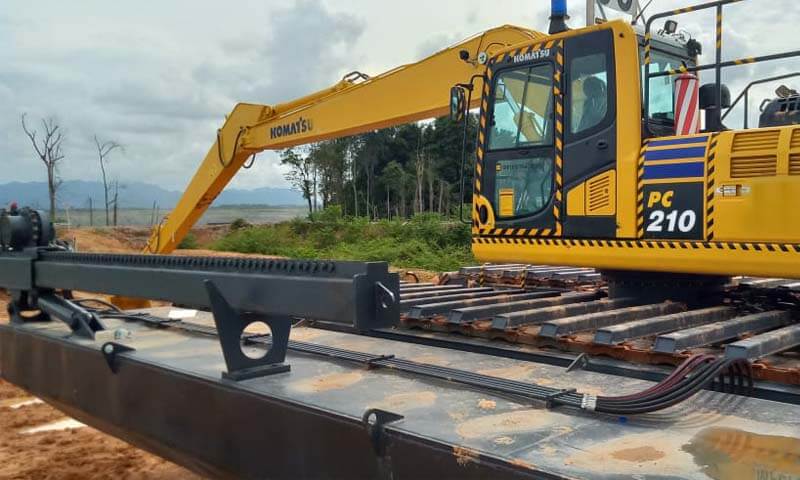Table of Contents
Excavator is one of the most common and widely used machinery in the field of construction machinery. On land, they can ignore the difference in terrain like a tank and operate under various conditions. However, with the development of engineering projects, ordinary excavators sometimes cannot complete engineering projects with special terrain. Although they have a tank-like crawler chain to assist walking, ordinary excavators are powerless in deep silt swamps and even waterways.
What is an amphibious excavator?
At this time, the amphibious excavator came into being. It is called differently in different regions, some are called swamp buggy, and others are called floating excavators. By replacing the crawler assembly of an ordinary excavator with a pontoon undercarriage, the amphibious excavator can enter the terrain that ordinary excavators cannot enter, expanding the usage scenarios of the excavator. As the name suggests, an amphibious excavator is an excavator that can walk on land and water. But in fact, to fully realize this function, there are still many subdivided models.
Amphibious excavators can choose different configurations in different working conditions to improve the use efficiency. After all, the ultimate purpose of using construction machinery is to complete the project as quickly as possible. Then it is very important to choose the appropriate combination according to different scenarios.
Scenarios for amphibious excavators
Swamps and wetlands
Swamp and wetland terrain is the terrain that best characterizes an amphibious excavator. No matter how deep the swamp is, because the amphibious excavator has a pontoon undercarriage, he can easily float on the swamp and walk. Not only the walking speed is fast, but also the steering is flexible, even more relaxed than on land.
Wetlands are even less of a problem than swamps. When an ordinary excavator enters the wetland, the soil will enter the undercarriage, affecting the mobility of the excavator. But amphibious excavators do not have this problem. It can easily walk in the wetlands, turn around, and complete the corresponding engineering tasks.

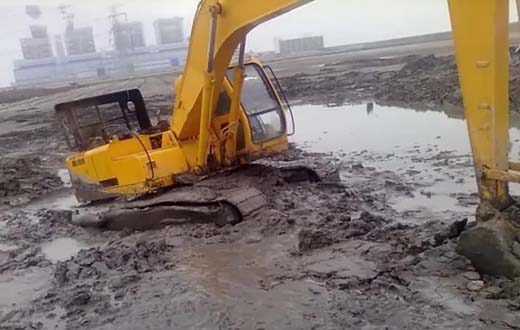
Ponds and fish ponds
Ponds and fish ponds are perhaps the places you’ll see amphibious excavators most often. In Europe and America, many private ranches have ponds. The fallen leaves and growing aquatic plants in the pond are the main reasons that affect the water quality of the pond. It needs to be cleaned every once in a while. Owning a small amphibious excavator can clean up ponds regularly.
Fish ponds are one of the most widely used places for amphibious excavators. After the silt in the fish pond is continuously deposited, even if the water is pumped out, it will form a swamp-like terrain. At this time, amphibious excavators are required to dig out the silt in the fish pond. This can not only ensure that the actual feeding area of the fish pond is not reduced, but also ensure the quality of the water in the fish pond and ensure a bumper harvest of fish.

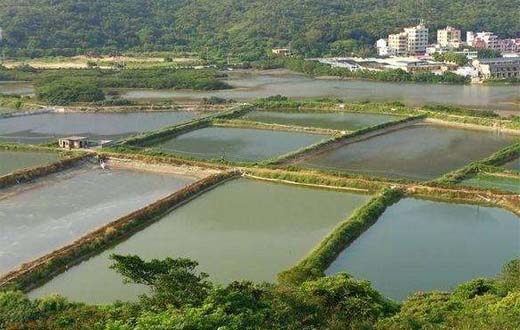
Waterways and river channel
Some projects that need to bury pipelines in waterways require the use of amphibious excavators. Ordinary excavators cannot work in watery silt. When some small rivers need to be dredged, large and medium-sized dredging vessels cannot travel. Ordinary excavators may fall into it when working along the canal with complex terrain. These are the times when people think of amphibious excavators.
In some rivers, although the ship can sail, it cannot perform its mission when the river is icy and snowy. The amphibious excavator can move while breaking ice, with strong maneuverability and higher efficiency. Amphibious excavators are also capable of cleaning up silt in the river and collecting river sand.


Lakes and coasts
Small lakes have been deposited over many years, and silt has formed at the bottom, which will reduce the water output of the lake. Many park landscape lakes also require regular maintenance. Some engineering projects even need to pump out all the water in the lake, remove the silt at the bottom and refill it with water. Such engineering projects are a good place for amphibious excavators to show their talents.
Construction projects on the coast are not uncommon. Amphibious excavators can be seen in beach remediation, piling at sea, and flood control and embankment construction. Amphibious excavators are used even in deep seas to work with other ships. After all, large amphibious excavators can even be used as offshore mobile platforms.

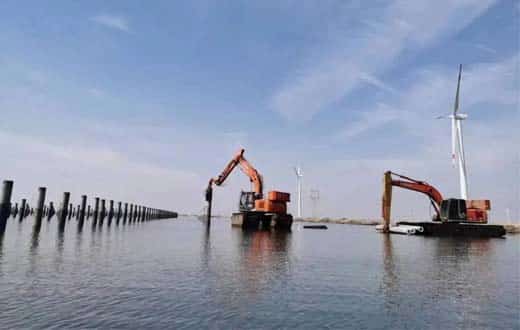
Combination forms that amphibious excavators can be matched with
Use the main pontoon alone
Using the main pontoon alone is the most common combination of amphibious excavators. Without additional accessories, it can travel and turn more flexibly, and the moving efficiency is much improved. And if you are sure that the project you undertake does not require construction in a fully floating state on the water, you can even reduce the size of the main pontoon. Thereby, the overall weight of the amphibious excavator is reduced, and the flexibility of the amphibious excavator is better. Of course, the main pontoon can also be a full-float type. In the working conditions of water depth not more than 2 meters, the safety can be completely guaranteed.
Add side pontoons
Although the main pontoon alone can be used to make the amphibious excavator float on the water, even walk and work. However, in deeper waters, the safety risk is still greater. At this time, if stable construction is required, it is recommended to add side pontoons. This enables the entire amphibious excavator to form a square-like platform. Compared with the rectangular design of the main pontoon, the square platform is more stable. In this way, the amphibious excavator can obtain all-round support when the upper body rotates, and the safety is higher.
Hydraulic spuds
If the excavation work needs to be carried out in a floating state in the engineering project, the amphibious excavator may not be able to find the supporting point, thus affecting the construction efficiency and even causing the risk of rollover. At this time, the hydraulic spud is a necessary auxiliary tool. Usually, hydraulic spuds have two specifications of 6 meters and 8 meters, and are suitable for water depths below 5 meters and 10 meters. Of course, some experienced drivers can even find support points for excavation work without using hydraulic spuds. If you are not so confident in your driving skills, it is more reliable to use tool to increase stability.
Hydraulic propeller
The hydraulic propeller is a newly developed auxiliary tool in the field of amphibious excavators in recent years. In general, the movement of amphibious excavators in deep water mainly relies on the support force generated by the extension of the boom to the bottom of the water. More and more conditions require amphibious excavators to work in deeper waters. At this time, the amphibious excavator will lose power and can only rely on other ships to drag it to move. The hydraulic propeller was developed to meet the need for the amphibious excavator to move itself in this situation.
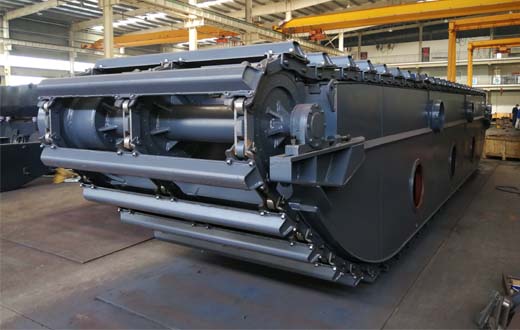
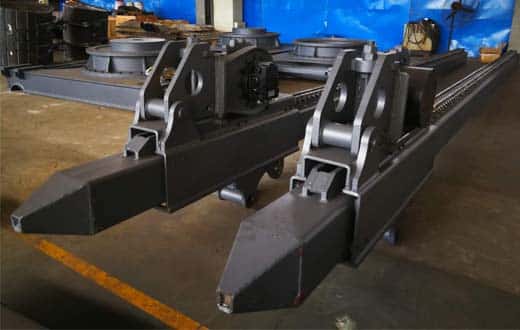
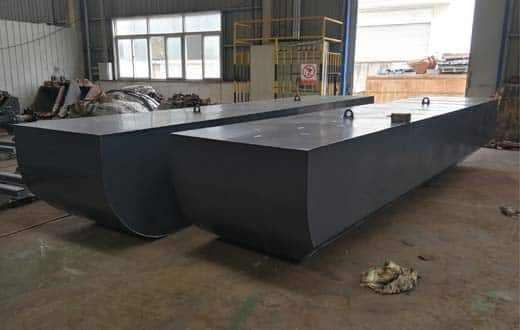
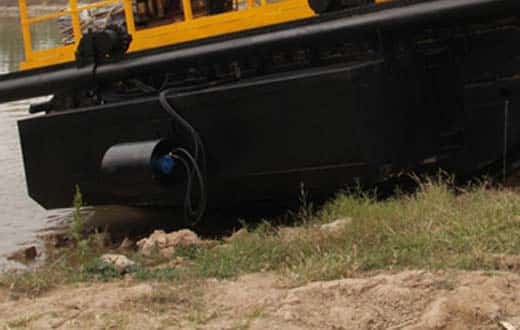
Why use an amphibious excavator
As can be seen from the above content, the application field of amphibious excavators is wide and still developing gradually. So why do many professionals in the field of construction machinery do not know what an amphibious excavator is? Because when encountering similar engineering projects, they usually consider placing a steel plate under the ordinary excavator to solve the problem of the excavator sinking. If you encounter a project that needs to work on the water, you will consider directly using the cutter suction boat.
Why do you need amphibious excavators when you can use these solutions for construction? We mentioned that the purpose of using construction machinery is to improve construction efficiency and complete project goals as soon as possible. The previous construction scheme, while feasible, was inefficient and unsafe. Although the cutter suction boat is efficient, it is bulky and inflexible in narrow water. These have promoted the development and progress of amphibious excavators.
Of course, there is still a lot of room for improvement in amphibious excavators. In large-scale engineering projects, other mechanical equipment is also required to cooperate with the construction. However, in some special terrains, amphibious excavators are already in a dominant position and are an irreplaceable solution for dredging engineering.

